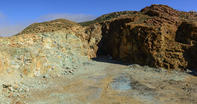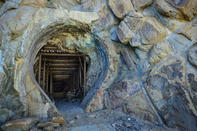Rich in Copper
The Phalaborwa region is fantastically rich in copper and other metal ores, and local tribes have been mining these valuable minerals for at least 1000 years.

Since copper was once a popular form of currency (carried about in the shape of a copper rod, or Lerale), the Phalaborwa region used to enjoy some degree of wealth and fame.
Today, the town of Phalaborwa is a significant mining centre and boasts one of the world’s largest open-cast copper mines. First ‘discovered’ by a South African geologist named Hans Merensky in 1938, this colossal mineral deposit was based around a hill named Loolekop (situated about 20 km to the west of Masorini). Subsequent investigations of Loolekop revealed that a number of shafts had been dug into the hillside by local tribes many hundreds of years previously.
Preservation of Masorini
These ancient, horizontal shafts (or adits) were generally around 20 metres deep and about 1 metre in circumference. There were no supports and it must have been a dark, dusty and dangerous job to scrape out the ore. Loolekop was clearly a very active iron-age mining site, but it was all blasted away in the name of progress when the modern copper mine was established. Much valuable archaeological evidence about the early African miners was thus destroyed.
The preservation of Masorini, within the confines of the Kruger National Park, is therefore of considerable importance. When the settlement was first identified, there were only a few scattered artefacts and ruins to be seen. Now, it has been reconstructed into an impressive open-air museum that attempts to re-create an authentic iron-age settlement. The museum is attractively laid out along the slopes of the hill, and there is a full complement of huts to admire and explore.

Agricultural implements are displayed and the distinctive dome-shaped furnaces used to smelt iron, have been restored. Masorini is open to visitors throughout the day and guided tours are available. It’s a fascinating stop and an excellent way to get to grips with the society and technology of a typical iron-age village. It is also a convenient picnic spot and gas braais can be hired.